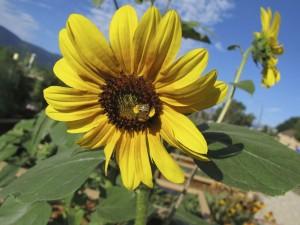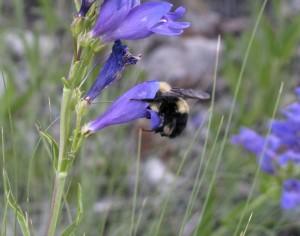Endangered Bees
We've all heard the bad news: populations of imported European honeybees and many of North America's 4,000 species of native bees are plummeting, sometimes dramatically. Recently, for instance, misuse of an insecticide sprayed on trees in a Target store parking lot in Oregon caused the largest mass mortality of bumblebees ever, killing at least 50,000 bumblebees. Whole imported honeybee colonies are dying off from the mysterious Colony Collapse Disorder.
Why Care About Bees?
We need these hard-working pollinators: they not only fertilize the flowers of plants critical to our food supply, they also help keep Earth's ecosystems healthy. They're important food for nesting songbirds; they help control the populations of pest insects; they form part of the web that makes up the grand community we call nature.
Want to know more about pollinators? Watch this fun and informative short video from The Nature Conservancy's "Nature Works Everywhere" curriculum.
The Good News: We Can Help
The good news is that gardeners can help support populations of native bees. An 8X10-foot garden planted with bee-friendly species that flower throughout the growing season can sustain your neighborhood pollinators.
Won't They Sting Me?
Native bees are remarkably easy to get along with. Unlike some wasps and European honeybees (which were imported to this continent from Europe and Asia), are not defending large colonies.
They're not interested in you; they're too busy gathering pollen and nectar to feed their "kids," the eggs they lay in solitary nest chambers in holes in the ground or dead wood. And in the doing, pollinating the flowers that beauty your garden and provide us with much of the food we eat and drink.
Good neighbors
Most native bees are so inoffensive that you can hold them in your hand and they won't be bothered. These good neighbors are probably already in your garden, whether bees as tiny as the period in this sentence buzzing around their favorite flowers, metallic green sweat bees hovering in mid-air like helicopters, or big fuzzy bumblebees lumbering along from blossom to blossom. Want to know what you're looking for? This Pollinator Partnership poster has illustrations and information on some of the common native bees.
More resources for creating gardens for bees in the Rocky Mountain area:
Tips from Colorado State University Extension Service (best for northern Colorado and Wyoming)
Pollinator Partnership booklet (best for high-desert climates in the Colorado Plateau region)
UC Berkeley's Bee Lab (best for California, but fun to use!)
By Habitat Hero
Stay in the Know
Sign up for emails to stay up to date on how you can help and enjoy birds in Colorado, Wyoming, and Utah.






